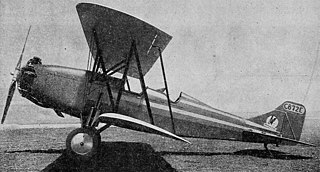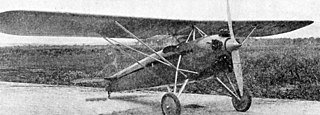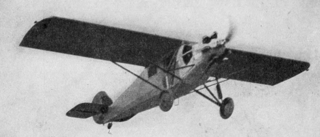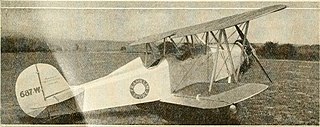The Weller UW-9 Sprint is a German ultralight aircraft designed and produced by Weller Flugzeugbau of Bibersfeld. The aircraft is supplied as a kit for amateur construction or as a complete ready-to-fly-aircraft.
The Potez 51 was a 1930s French intermediate trainer, intended to replace the ageing Potez 25 which had sold worldwide. It did not go into production.

The Raab-Katzenstein KL.1 Schwalbe (Swallow) was a German two-seat biplane produced in the 1920s. About fifty were built and the type became well known as an aerobatic aircraft, performing at many displays in the hands of pilots like Gerhard Fieseler.
The Hess H-2 Blue Bird was a small US transport biplane, built in the 1920s and carrying two or four passengers according to engine power.
The Brown 1926 parasol monoplane was a 1920s US, three seat, parasol wing civil aircraft developed from a biplane wartime scout. It was intended for either the private or commercial passenger markets, though one was used as a crop-duster.
The Yackey Monoplane was an American three seat parasol monoplane flown in the late 1920s. Two prototypes had some success in the 1927 New York - Spokane National Air Derby and orders were placed but a crash killed its designer and ended production.

The Laird LC-B was a three seat, single-engined biplane, built for private owners in the U.S. in the late 1920s and offering a variety of engines. About 35 had been built before production ceased in the mid-1930s. Two have been restored to flight.
The Stiles Dragon Fly was an American two seat monoplane aircraft of the late 1920s. It was aimed at private and club owners. Significant production was planned but few were built.
The Pacer Monoplane was a parasol wing, four seat, light aircraft, flown and produced in the US in the late 1920s.
The Simplex Red Arrow was a US single-engined monoplane produced in the late 1920s and early 1930s and intended as club machine or mail transport. Most used radial engines in the 90–110 hp (67–82 kW) range. They carried one or two passengers whose seats could be open or enclosed. One variant, the Red Arrow Dual Plane, was easily converted from monoplane to biplane and was available with two versions of the much more powerful Wright Whirlwind engines. In all about 20 were built.

The American Eagle Phaeton was an American three seat, single engine sports biplane produced from 1929 until American Eagle failed financially in 1932. About 34 were built.

The Inland Sport series of parasol wing, sport and training side-by-side two seaters, introduced between 1928 and 1930, differed chiefly in their engines. They used three different radial engines, more than doubling the Sport's power over two years of development. 34 examples were built and frequently re-engined.

The Neilson NC-1 Golden Bear, aka Neilson Coach was an American, three-place, high wing cabin aircraft, flown in 1929. It did not go into production.

The Wallace Touroplane was a late 1920s U.S. three seat, high wing cabin monoplane. About 20 were built.

The Watkins Skylark was an American low-wing, cantilever two-seater designed for private and club use. A large anticipated production run in 1930 ended early when the company collapsed in the Great Depression, with only five or six registered.

The Zenith Albatross Z-12 was a large, three-engined airliner built in the United States in 1928. It could carry up to 11 passengers. Only one was completed.

The Franklin Sport is a two seat sport and training biplane built in the U.S. in 1930. Several different engines, in the power range 55–90 hp (41–67 kW), were fitted. Two remained airworthy in 2011.

The Ireland Neptune was a four or five place pusher configuration biplane sold in flying boat and amphibian versions. Designed in the U.S. and first flown in 1927, well over 50 were built.

The Lincoln AP was a U.S., single engine, high wing, general purpose civil cabin aircraft first flown in 1930. Only four were built.

The Zenith Z-6 is a single engine biplane U.S. airliner built in the late 1920s. Its cabin, in the fuselage immediately behind its radial engine, holds five or six passengers depending on engine power. It is flown from an open cockpit further aft. Nine were completed and one has been restored to flight.















